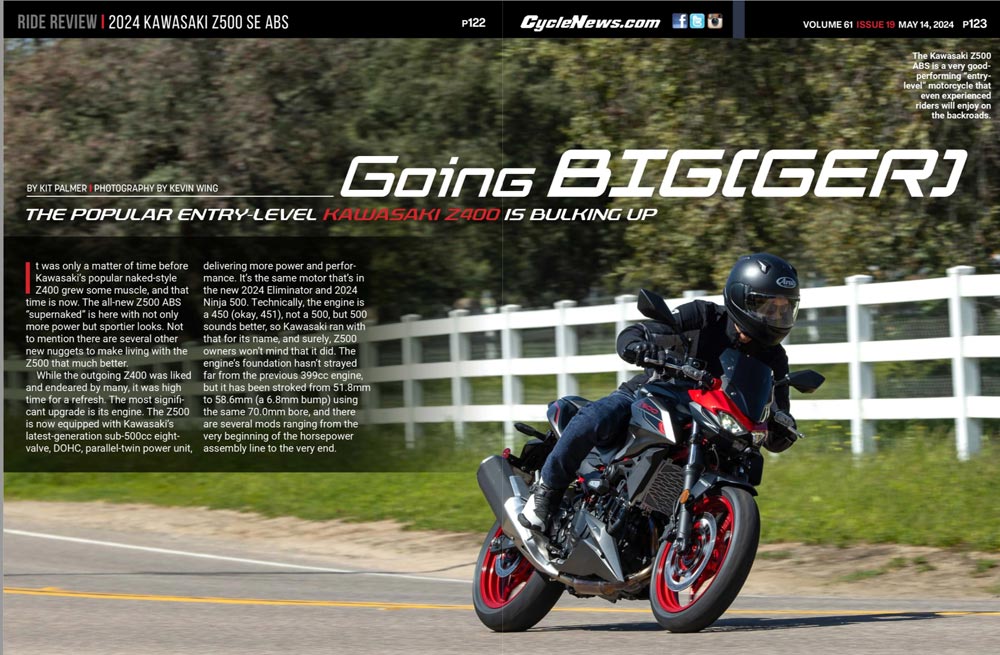Kit Palmer | May 19, 2024
It was only a matter of time before Kawasaki’s popular naked-style Z400 grew some muscle, and that time is now. The all-new Z500 ABS “subernaked” is here with not only more power but sportier looks. Not to mention there are several other new nuggets to make living with the Z500 that much better.
 The Kawasaki Z500 ABS is a very good-performing “entry-level” motorcycle that even experienced riders will enjoy on the backroads.
The Kawasaki Z500 ABS is a very good-performing “entry-level” motorcycle that even experienced riders will enjoy on the backroads.
Photography by Kevin Wing
While the outgoing Z400 was liked and endeared by many, it was high time for a refresh. The most significant upgrade is its engine. The Z500 is now equipped with Kawasaki’s latest-generation sub-500cc eight-valve, DOHC, parallel-twin power unit, delivering more power and performance. It’s the same motor that’s in the new 2024 Eliminator and 2024 Ninja 500. Technically, the engine is a 450 (okay, 451), not a 500, but 500 sounds better, so Kawasaki ran with that for its name, and surely, Z500 owners won’t mind that it did.
The engine’s foundation hasn’t strayed far from the previous 399cc engine, but it has been stroked from 51.8mm to 58.6mm (a 6.8mm bump) using the same 70.0mm bore, and there are several mods ranging from the very beginning of the horsepower assembly line to the very end. It all starts with the all-new airbox; it’s larger and more efficient. There are also new injectors, larger intake and exhaust valves, and new spark plugs, and the crankshaft, connecting rods and pistons, as well as the cylinders, have been updated. At the end, spent gasses are blown out of a new exhaust system that Kawasaki says improves high-rpm performance to go along with the bike’s increased torque.
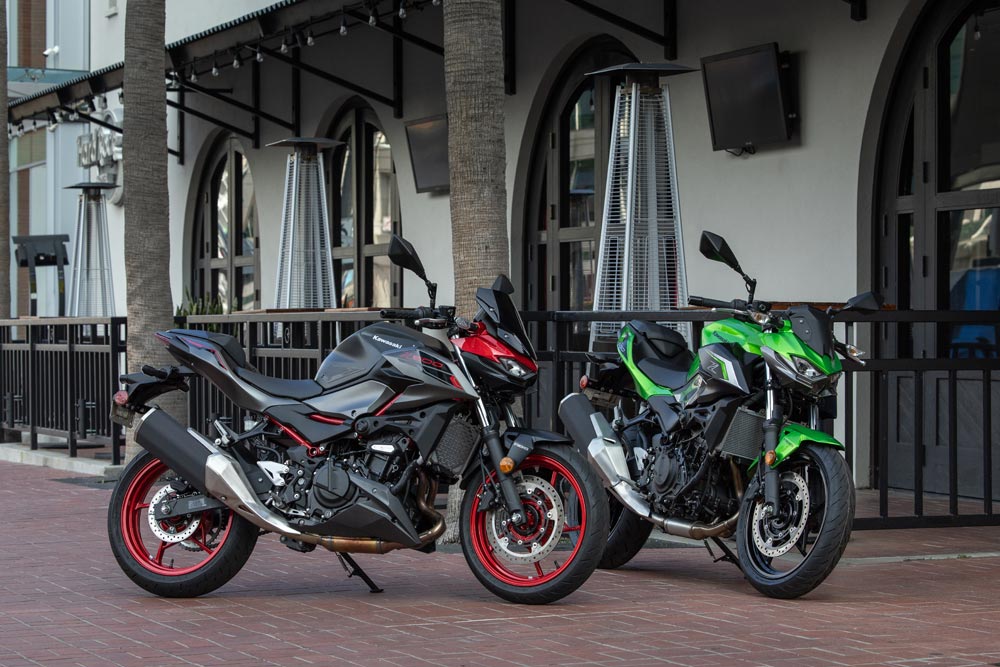 The Z500 ABS comes in two versions: the standard model (right) and the SE. Performance-wise, they are the same, but the SE has a little more bling.
The Z500 ABS comes in two versions: the standard model (right) and the SE. Performance-wise, they are the same, but the SE has a little more bling.
With its enhanced torque and overall power, the Z500 now boasts a beefier clutch—still an assist and slipper clutch—and an updated transmission. A new radiator fan has been added to direct hot air out to the side of the bike and away from the rider for a more comfortable ride when it’s hot outside. The overall physical size of the engine remains unchanged to preserve the excellent handling performance of the previous model.
Yes, the Z400 was well-known for its great and easy-going handling mannerisms, so Kawasaki didn’t want to mess with that. This is why there are few changes to the bike’s chassis and suspension. The Z500 rolls on the same trellis frame, wheels, and suspension package as before. Even the 310mm front and 220mm rear disc-brake systems are the same. ABS is standard equipment.
However, a lot has changed in the visual and comfort departments. Kawasaki researchers say that sporty looks are way up there on the buyer’s priority list when shopping for a motorcycle in the middle-bore streetbike category, so it got a style revamp. After all, no one wants to look like they’re riding a motorcycle that some might perceive as a “beginner’s” bike. As a result, the new Z500 gets updated bodywork and a new LED headlight and taillight, just like the higher-end Z650 and $18,000 Z H2 models. The Z500’s fuel tank is slimmer and lighter but holds slightly less, at 3.6 gallons versus the 400’s 3.7 gallons. To improve comfort, the seat has been reshaped for a flatter profile and is now made from low-rebound urethane, and the footpegs are positioned slightly farther forward for an improved upright rider position. The mirrors are also updated.
There’s also an all-new high-contrast LCD instrumentation screen that is a major improvement over the previous Z400’s.
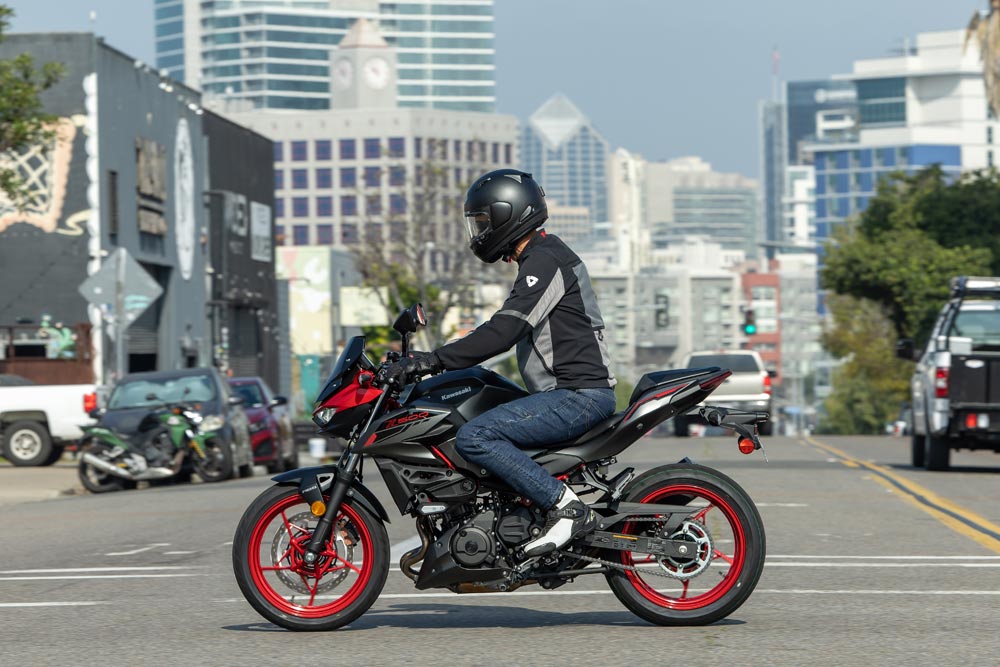 The Z500 and the city get along nicely.
The Z500 and the city get along nicely.
Kawasaki offers two Z500 models: the standard Z500 and the Z500 SE, the latter of which I rode here. Performance-wise, the Z500 and Z500 SE are the same motorcycles, but the SE features several smaller upgrades. The most significant is the SE’s TFT full-color instrumentation with Bluetooth technology, which allows you to connect to the bike wirelessly via your smartphone and Kawasaki’s Rideology The App. Not often do you find a premium item like this (TFT) on an “entry-level” motorcycle.
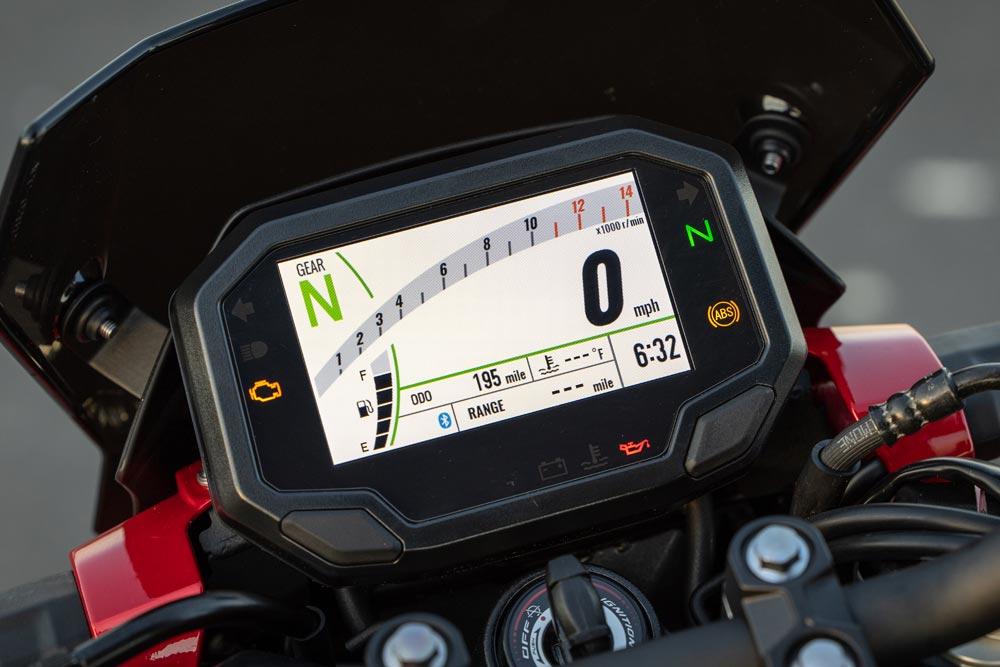 Both models have upgraded screens, but the SE gets a full-color and adjustable TFT (shown) screen.
Both models have upgraded screens, but the SE gets a full-color and adjustable TFT (shown) screen.
The SE also has, that you don’t get with the standard Z500, LED turn signals, a smoke-tinted meter cover, a radiator screen, frame sliders, a rear-seat cowl, a tank pad, knee pads, a type-C USB charger and an under cowl. You get all that for an additional $700 of the standard’s $5599 MSRP. However, you can buy any of these items separately for your standard Z500 from the Kawasaki Genuine Accessory catalog. You also get approximately four more pounds with the SE: 370 pounds versus the standard’s 366 pounds. They also have their own unique colorways; that pretty and distinctive Kawasaki Candy Lime Green color is available only on the standard model.
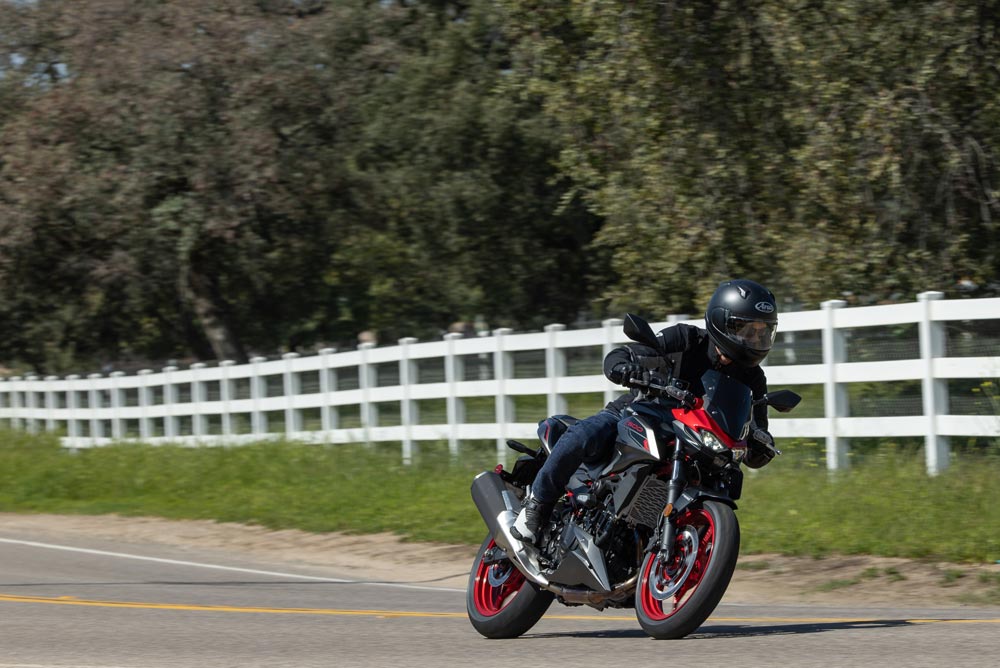
Rolling, Rolling, Rolling | 2024 Kawasaki Z500 SE ABS Review
I’ll get straight to the meat and potatoes. The new Z500 is all the Z400 was, but better. The Z400 was already a great-handling motorcycle, and that hasn’t changed in the slightest, but it has more power now in the Z500. And who doesn’t want more power? Throw in a more comfortable seat, a much-improved LCD screen and updated looks, and you have another winner on your hands.
Even though the Z500 has more power than the 400, 51 horsepower versus the Z400’s 43 horsepower (Kawasaki claims), it’s not any trickier for the entry-level rider to manage. In fact, it’s probably easier, thanks to its improved torque (31.7 lb-ft at 7500 rpm versus the 400’s 24.5 lb-ft) and bottom-end. You don’t have to rev it as much to get the bike moving from a stop and up to speed. There’s no explosive hit anywhere in the bike’s ultra-smooth and linear powerband, and shifting gears is a breeze. It takes just a slight nudge on the foot lever, and you’re already in the next gear. A light clutch pull that offers smooth engagement only makes gear-changing all that much easier for both the newbie and experienced rider. Plus, the slipper clutch eliminates any fears one might have about skidding or hopping the rear wheel if you botch a downshift at speed.
 The Z500’s parallel-twin engine gets its large displacement via a longer stroke. Various other mods give it approximately 12 more horsepower compared to the Z400.
The Z500’s parallel-twin engine gets its large displacement via a longer stroke. Various other mods give it approximately 12 more horsepower compared to the Z400.
The Z500 accelerates well. Kawasaki says many prospective buyers are concerned about a “small” two-cylinder-powered motorcycle having enough ponies to merge safely with traffic from freeway on-ramps. Not to worry; the Z500 has plenty and is plenty fast, and unless the on-ramp is 10 feet long, you won’t have any problems reaching freeway speeds quickly and staying there comfortably. The Z500 hums along comfortably at 70 mph in sixth gear, and you can still accelerate from there if needed. You will, however, notice a slight buzz through the bike’s seat and handlebars around 6500 rpm, but you get used to it. I doubt, however, that you will be logging long freeway miles commuting on the Z500 anyway. That’s not really its forte. Instead, it’s very happy in the city and in the canyons, where its newfound torque and power make the Z500 a pleasure to tap through the gears from stop sign to stop sign and roll on the throttle from turn to turn. The Z500 brakes are also capable of slowing the bike down from speed in a hurry and confidently without requiring much effort from the rider.
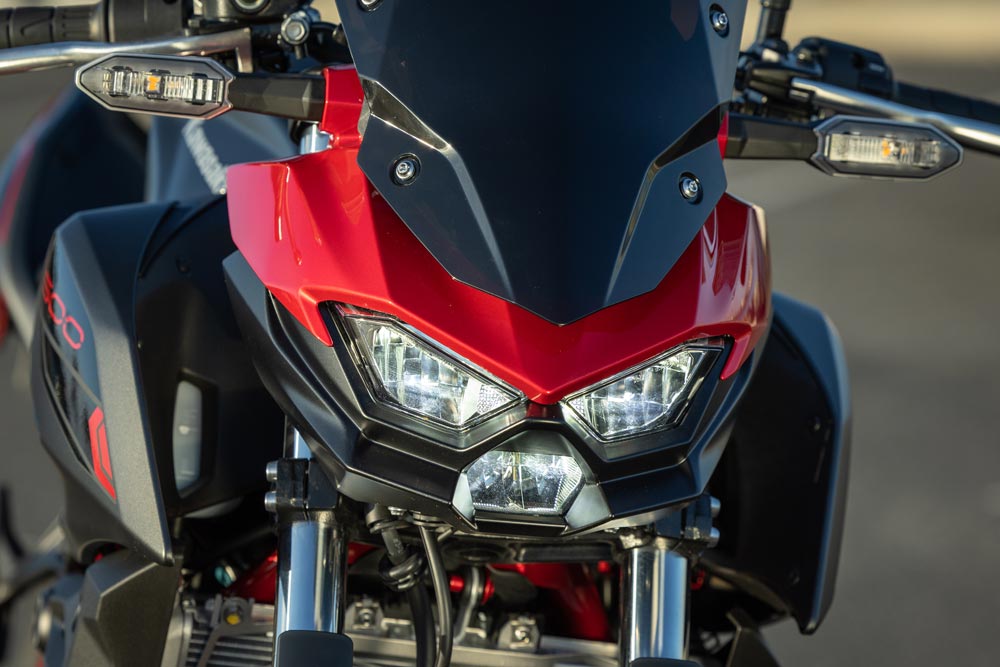 New styling doesn’t look entry-level. The Z500 is a looker.
New styling doesn’t look entry-level. The Z500 is a looker.
The Z500’s exhaust note is also pleasant and inspiring, which is not usually the case with parallel-twins, and adds greatly to the Z’s overall riding experience.
Kawasaki found a good all-around suspension setting for the Z500 that should appeal to a wide range of riders, which is a good thing since neither the rear Uni-Trak single shock nor the front 41mm Showa fork is adjustable, except for the shock’s five-way preload settings. For my 165 pounds, the Z500 offered a firm but comfy ride, and the fork had excellent feedback.
The Z500 has a somewhat short wheelbase at 54.1 inches. With 24.5° of rake and 3.6 inches of trail, the bike is quick and agile on its feet while feeling very light at the controls. Despite being so flickable, the Z500 is still very stable at speed and through sweeping corners.
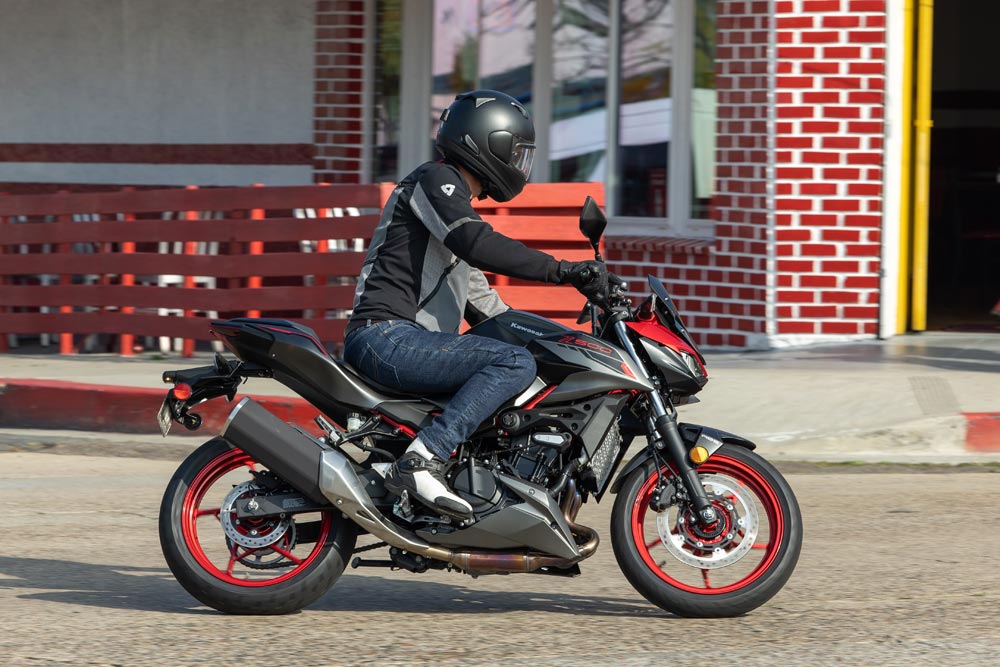 You get a lot of motorcycle for the Z500’s $5599 price tag; $6299 for the SE.
You get a lot of motorcycle for the Z500’s $5599 price tag; $6299 for the SE.
I found the Z500’s upright riding position comfortable despite my 6’1” height and its low 30.9-inch seat height. I didn’t feel too crunched up in the cockpit, and my knees never complained, though my longest stint on the bike was only approximately 45 minutes while attending Kawasaki’s press launch in San Diego.
As mentioned, I rode the SE model, and I was impressed by the new full-color TFT screen and its adjustable background. It gives the Z500 SE that premium look while being easy to read and decipher. I have little doubt TFT screens will become the norm on most entry-level street motorcycles in the future, but the Z500 SE will have the distinction of being one of, if not, the first.
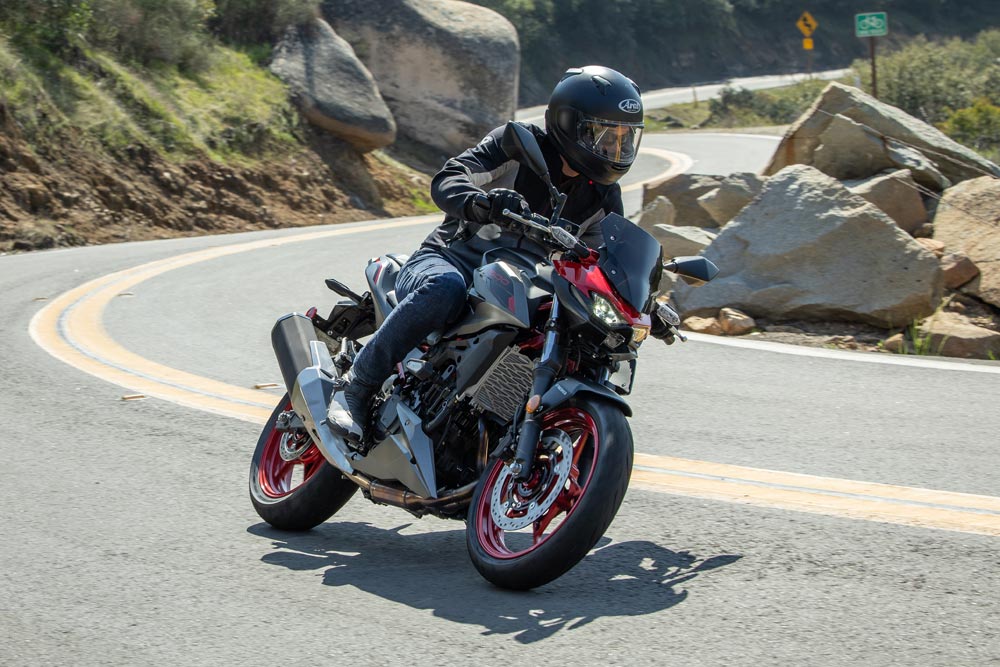 After doing its job nicely in the city, the Z500 lives for the weekends out in the country.
After doing its job nicely in the city, the Z500 lives for the weekends out in the country.
Final Thoughts | 2024 Kawasaki Z500 SE ABS Review
Kawasaki says of the new Z500: “This aggressively styled streetfighter is for those who are not afraid to be seen.” I’d have to agree. It’s a good-looking motorcycle that doesn’t have “I’m a newbie” written all over it when you ride past a crowd. Even experienced riders will feel good about themselves on the Z500. But more importantly, the Z500 is an all-around excellent-performing motorcycle that will appeal to a wide range of riders and skill levels.
However, an entry-level rider will benefit most from the Z500 because of its attractive pricing, user-friendly motor, predictable handling, light weight, small size and low seat height. Best of all, the Z500 performs so well that you won’t be in a hurry to part with it after your confidence level rises.
It’s a keeper.CN
VIDEO | 2024 Kawasaki Z500 First Ride
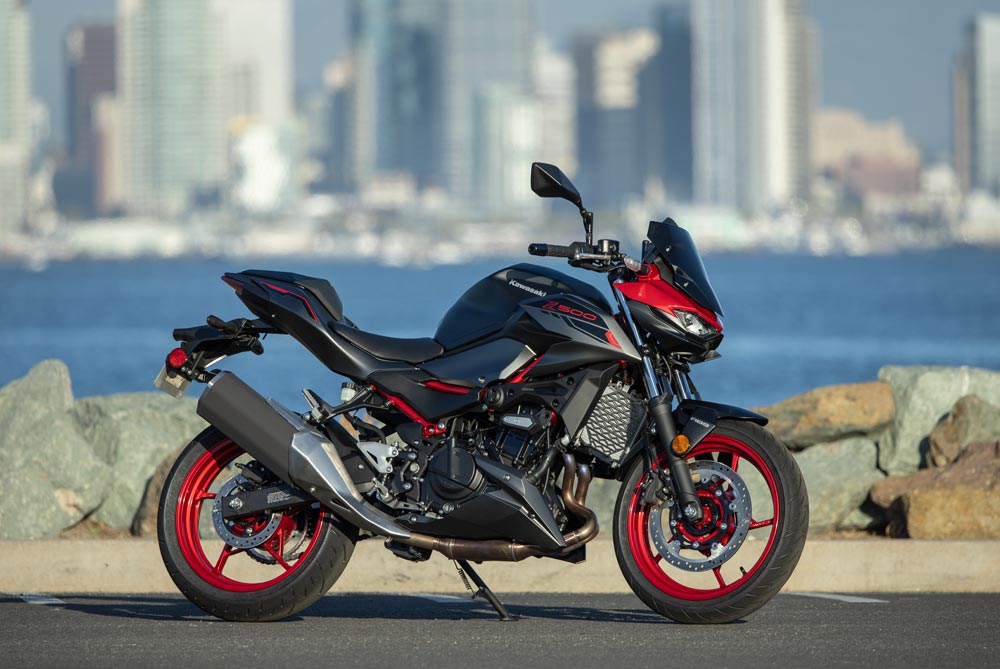
2024 Kawasaki Z500 ABS / SE ABS Specifications
| Engine |
Parallel-twin, 4-stroke |
| Displacement |
451cc |
| Bore x Stroke |
70.0 x 58.6mm |
| Valvetrain |
DOHC, 8-valve |
| Compression Ratio |
11.3:1 |
| Cooling system |
Liquid-cooled |
| Transmission/Final Drive |
6-speed |
| Horsepower (claimed) |
51.0 hp at 10,000 rpm |
| Torque (claimed) |
31.7 lb.-ft. at 7,500 rpm |
| Fuel System |
EFI w/ dual 32mm throttle bodies |
| Clutch |
Wet, multiplate assist/slipper |
| Engine Management/Ignition |
TCBI w/ electronic advance |
| Frame |
Steel trellis |
| Front Suspension |
41mm Showa hydraulic telescopic fork, non-adj. |
| Rear Suspension |
Uni-Trak shock, 5-way spring preload adj. |
| Front-Wheel Travel |
4.7 in. |
| Rear-Wheel Travel |
5.1 in. |
| Front Brake |
2-piston caliper, 310mm semi-floating disc, ABS |
| Rear Brake |
2-piston caliper, 220mm disc, ABS |
| Front Tire |
110/70-17 in. |
| Rear Tire |
150/60-17 in. |
| Rake/Trail |
24.5°/3.6 in. |
| Wheelbase |
54.1 in. |
| Ground Clearance |
5.7 in. |
| Seat Height |
30.9 in. |
| Fuel Capacity |
3.7 gal |
| Weight (Wet, claimed) |
366 lb / 370 lb (SE) |
